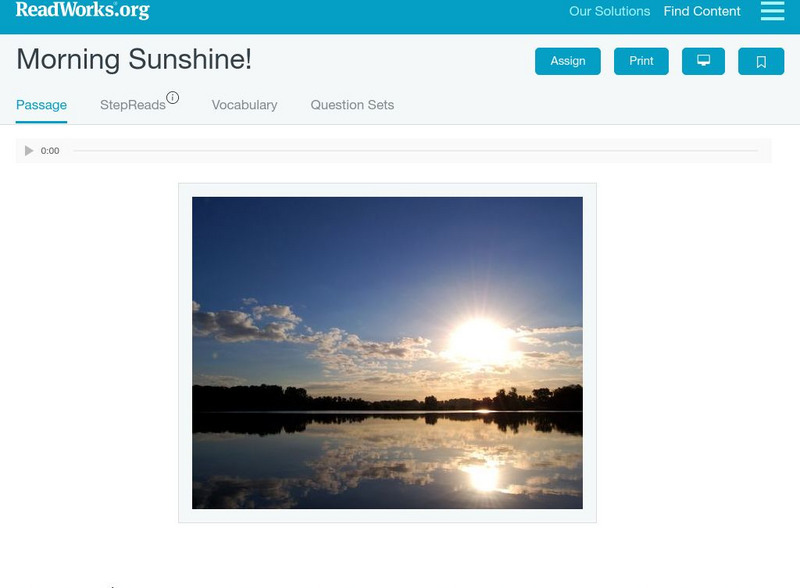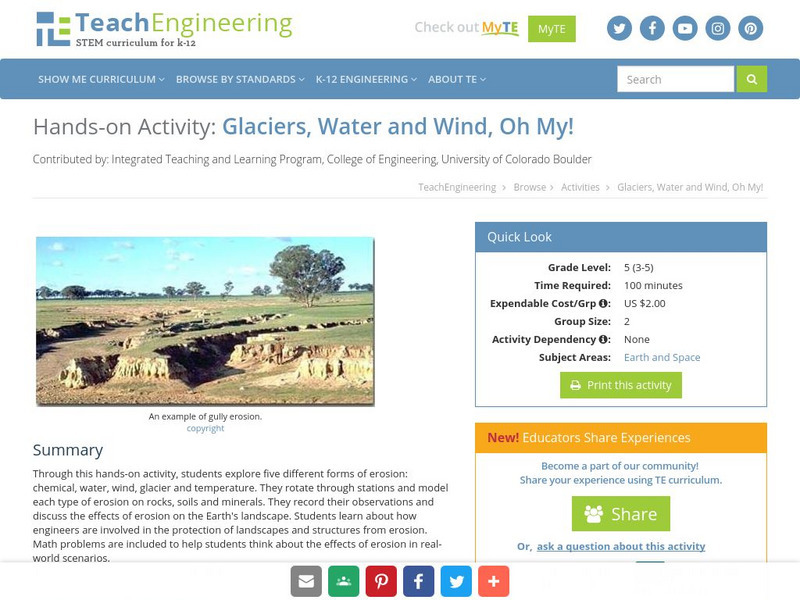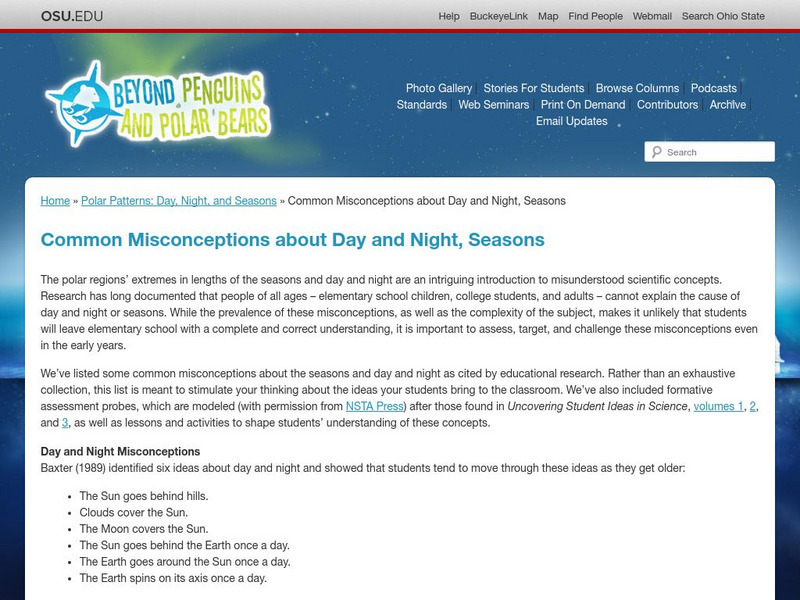Utah Education Network
Uen: Trb 3:1: Investigation 4: Day and Night
A lesson for third graders in which they learn about the rotation of the Earth on its axis and how this movement creates day and night. They also examine the orbit of the moon about the Earth and the Earth's orbit around the sun.
Science Education Resource Center at Carleton College
Serc: Seasons
For this activity, students create a small model of the Earth using a styrofoam ball and a skewer. They then explore the relationship between the Earth and the Sun (a flashlight) to understand why it is hottest at the Equator, and why we...
Curated OER
Global Wind Pattern on the Earth Without an Ocean, Axiz Tilt, and Rotation.
Global wind pattern on the earth without an ocean, axiz tilt, and rotation.
Read Works
Read Works: Morning Sunshine
[Free Registration/Login Required] Students read about how the tilt of the Earth on its axis affects sunrises and sunstes. A question sheet is available to help students build skills in reading comprehension.
CK-12 Foundation
Ck 12: Plix: Seasons
[Free Registration/Login Required] This site contains an animation showing how the seasons are produced by the tilt of Earth's rotating axis. Site also includes a short quiz over the topic of seasons.
TeachEngineering
Teach Engineering: Lunar Lollipops
The students work in teams of two to discover the relative positions of the Earth, Sun and Moon that produce the different phases of the Moon. The students will be given a Styrofoam ball that they will attach to a pencil so that it looks...
NASA
Climate Kids: 10 Interesting Things About Earth
Discover 10 interesting things about Earth, including its shape, its seasons, rotation, Ice Ages, the Atacama Desert, gravity, changing sea levels, and the Moon.
University of Chicago
University of Chicago: What's Your Slant? Sun and Shadows
This fun activity helps you to understand the movement of the sun by studying shadows.
Exploratorium
Exploratorium: Science Snacks: Reflections of a Star
This simple lesson allows students to work cooperatively in determining the angular diameter of the Sun.
McREL International
Mcrel.org: Planet Rotation [Pdf]
A worksheet regarding the axis of rotation within each of the planets. PDF
Utah STEM Foundation
Utah Stem Action Center: Together We Can Rule the Galaxy
In this lesson, students will learn about Galileo Galilei and space.
OpenStax
Open Stax: Gyroscopic Effects: Vector Aspects of Angular Momentum
From a chapter on Rotational Motion and Angular Momentum in a Physics textbook. This section of the chapter explains how to use the right-hand rule to determine direction for angular velocity, momentum, and torque. Also discusses the...
TeachEngineering
Teach Engineering: Glaciers, Water and Wind, Oh My!
This hands-on activity explores five different forms of erosion (chemical, water, wind, glacier and temperature). Students rotate through stations and model each type of erosion on rocks, soils and minerals. The students record their...
Curated OER
Earth Rotates Toward the East
This site from the National Aeronautics and Space Administration provides a fun project on rockets. "Nothing in space stands still. Everything either orbits around something else, or moves toward or away from something else. So how do...
Science Struck
Science Struck: A Scientific Explanation to What Causes Day and Night
Explains how the rotation and the axial tilt of the Earth are responsible for the phenomenon of day and night. Provides information about the Sun, the solar system, and the Earth, and how the circumference of the Earth was first measured...
Cornell University
Cornell University: Astronomy: Eratosthenes
Learn how Greek mathematician Eratosthenes used geometry to estimate the circumference of the Earth.
Utah Education Network
Uen: Trb 3:1 Investigation 6 Celestial Model
Third graders will gain an understanding of why stars appear to move across the night sky.
E-learning for Kids
E Learning for Kids: Science: Atlantic Ocean: Day and Night
This module explores day and night. Learn about what we see during the day and night and why we see what we see.
Texas Education Agency
Texas Gateway: Gyroscopic Effects: Vector Aspects of Angular Momentum
By the end of this section, you will be able to describe the right-hand rule to find the direction of angular velocity, momentum, and torque; explain the gyroscopic effect; and study how Earth acts like a gigantic gyroscope.
PBS
Pbs Learning Media: Meteor Showers
This video segment adapted from NASA uses animation to illustrate the properties of meteor showers and comets. Included is are visualizations of a comet's tail and of Earth passing through a debris stream left behind by meteoroids.
Better Lesson
Better Lesson: Our Stars
In this lesson, learners will observe and communicate how the stars are in the sky both day and night. The extremely detailed lesson includes photos and videos of the lesson in actions, examples of student's work, materials, parent...
Better Lesson
Better Lesson: Our Sky
What objects are in the day sky and the night sky? How do they seem to move? Come and explore with us as we discover the sun, moon, planets and stars! This detailed lesson plan includes pictures and videos of the lesson in action,...
Ohio State University
Beyond Penguins and Polar Bears: Common Misconceptions About Day and Night
Misconceptions about the causes of seasons and day and night are common through all ages. Use the information on this site to help your students understand these concepts. Included are links to many resources and lesson plans for...
Other
Electric Sky: Vernal Equinox
This site, created by an amateur who has studied astronomy for thirty years, provides a scholarly explanation of the vernal equinox. Links to definitions of significant terms.















